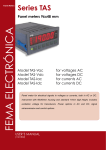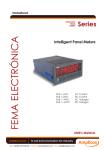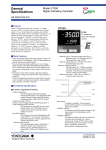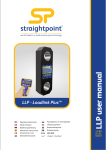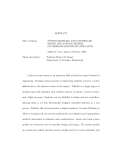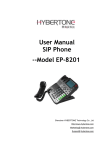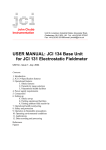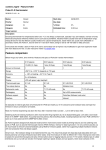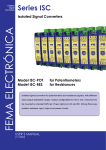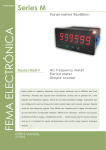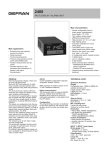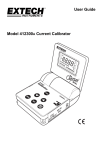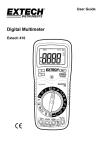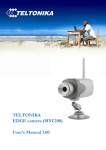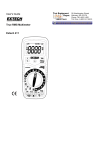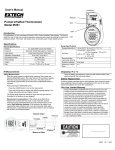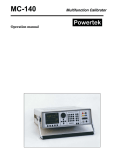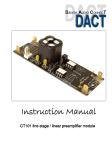Download FEMA ELECTRÓNICA
Transcript
Series TAS Panel Meters FEMA ELECTRÓNICA Panel meters 96x48 mm Model TAS-TP for process signals, temperatures, resistances, and potentiometers Panel meter for process signals in mA and Vdc, both active and passive, temperatures from Pt100 and thermocouples, resistances and potentiometers. Instrument with 96x48mm housing and standard 14mm digit height, includes excitation voltage for transducers. Power options in AC and DC, signal retransmission and control options. USER’S Manual (1320r01) User’s Manual TAS-TP Model TP Panel meter 96x48mm size for process, Pt100, thermocouples, resistances and potentiometer signals Panel meter for process signals both active and passive, in mA and Vdc, generated from 2 or 3 wire transducers. Includes excitation voltage to power-up the transducer. Size 96x48mm DIN standard instrument, with standard 14mm digit height, and 4 1/2 digit resolution (maximum 32000) and negative sign. Connections via plug-in screw terminals and configuration via front push-buttons. For ap- plication on industrial environments. Power options in AC and DC and additional control and/or retransmission modules. The instrument can manage up to 4 alarms. Order Reference Model TAS - TP Power - - 0 -0 -1 -6 Option1 230 Vac 115 Vac 24 Vdc ---EXP -AL2 -AL4 Option2 - ---TSAT -R485M -TEK Option3 - ---TEK Read first * When the instrument is powered, a message displays the configured signal (see section 2 or section 4) * If while in operation, the instrument shows a message on display see section 4.11 «Messages and Errors» * The frontal keypad of the instrument has two functions, «numerical» and «direct access» function : Key AL - Access to the alarm setpoint Key HI - High display value (High) Key LO - Low display value (Low) Key ADJ - Field correction Key DP -Decimal Point position PROG - introduce programming codes (4 digit codes, see section 4) * MESSAGE «TIME».- The current programing procedure has been stopped because there has been no interaction from the user for the last 5 seconds * SIGNAL RANGES.- To work with a signal range which is not directly shown in this manual, select the closest upper range and change the calibration parameters with code [14 11]. * Example .- to configure a 0/5 Vdc signal from a 0/10 BAR transducer : 1.- select the 0/10 Vdc range 2.- enter code [14 11] 3.- edit 0 Vdc = 0 and 5 Vdc =10,000 * If afterwards the value of 10.000 needs to be changed, it can be directly accessed and changed with key «HI». FEMA ELECTRÓNICA - Page 2 User’s Manual TAS-TP 0 Front view 1 Signal connections Display Value 5 displays 7 segment Alarm Status 1,2,3 and 4 Connections for Temperature Connections for Process Signals Signals Led indicating operation E D C B A 0...25 mV 0...100 mV 0...1 V 0...10/50 mA 0...4/20 mA E D C B A 0/10 V 0/100 V E D C B A -100/+100mV -5/+5 mA -1/+1 mA E + D THERMOCOUPLE C B A E D C B A -10/+10 V E D C B A E D C B A Units E D C B A PT 100 2 wires E D C B A PT 100 3 wires + - Decimal point Keypad Function led (Red numerical, Green direct access) 6 key programming pad double function E D C B A Connections for optional boards Input Signal E D C B A + - Power 2 1 PC Configuration jack connector Phase (-) Vexc output + and Vexc adjust 10...24Vdc (not in all models) Earth Phase (+) + - PT 100 4 wires + - Potentiometer Resistance 2 Programming menu t ra s es oc Pr pe e ur rm m Te 11 XX 12 XX 1 rm 2 rm 3 rm a Al a Al a Al a Al 13 11 13 12 13 13 13 14 4 re ste M Hy d S an g itin s Ed ent m m Te 13 15 14 11 14 12 12 11 Thermocouple K AL 1 ACTIU 11 12 12 12 Thermocouple J OFF 0/100mVdc 11 13 0/10Vdc 12 13 Thermocouple E 11 14 0/20mAdc 12 14 Thermocouple T 11 15 4/20mAdc 12 15 11 21 0/50mAdc Thermocouple R 12 21 Thermocouple S 11 22 10/50mAdc 12 22 11 23 -10/+10Vdc Thermocouple B 12 23 Thermocouple DIN J 11 24 -100/+100mVdc 12 31 PT 100/2 wire 11 25 -5/+5mAdc 12 32 PT 100/3 wire 11 31 -1/+1mAdc 12 33 PT 100/4 wire ON ↵ 1 AL LO AL HI ALSET HIST EDIT IN LOXXXXX 1 2 CENTR 3 1 ↵ ↵ SMODE ON ↵ INPUT ↵ 1º 0.1º ↵ IN HI XXXXX DL1 XXXXX DI HI XXXXX LED 1 Alarm Setpoints Correcting the HIGH input signal Correcting the HIGH input signal Adjusting the LOW Indication Adjusting the HIGH Indication Decimal Point Position INV DIR 1 ON OFF PASSWORD XXXX DEF CONFR ↵ ↵ INPUT ON OFF 1 1 ONERR ON OFF ↵ FIL 1 FIL 2 1 2 3 INPUT ADJT 1 1 TARE HI LO 1 1 ↵ INPUT ↵ 1 1 ITS ITS90 AVERA REAL 1 1 ↵ 1 1 ↵ 1 ↵ INPUT FIL 3 ↵ ITS68 ↵ TEXT INPUT 14 22 ADQN 385 ↵ ↵ 1 1 ALFA 392 Configuration : Direct Access ON ↵ 1 1 ↵ ↵ ↵ ↵ 11 51 0/100Vdc OFF FILT ON 11 42 POT2 < 400 Ohms DISPLAY NULL 14 21 ↵ LAST 1 1 CJ OFF 14 15 * ↵ ↵ ↵ HIST XXXXX 11 43 Resistance < 5 K 1 1 RESOL 1 14 14 ↵ ↵ 1 OFF AL-1 XXXXX ºC ↵ DI LO XXXX 14 13 TEMP UNITS ºF iza INPUT 1 ↵ STRING XXX ↵ INPUT FEMA ELECTRÓNICA - Page 3 rs te e pe l m na Ty ra Sig tion et t Pa w c s ul Lo orre Re efa C D at re ad * rT o yp ng r Er ent Ke cki m Blo n tio al su Vi ↵ RIGHT LEFT TIPE 11 32 0/25mVdc 11 41 POT1 < 5K 1 1 e ur t ra pe ↵ ↵ 11 11 0/1Vdc t- us j Ad sis STEP XXXXX ↵ INPUT * IMPORTANT: Before validating a PASSWORD with the Keypad Blocking menu, remember the 5 digit number you are about to enter. The instrument will not accept any future order until the same 5 digit password is reintroduced. User’s Manual TAS-TP 3 Direct access configuration Section 3.1 shows how to enter a code to select a defined input signal range. Codes are indicated in section 2. Examples in section 3.2 show how to use Direct Access buttons on frontal keypad in order to configure a input of 4/20 mA with an indication of 0.0 / 250.0 using the field correction signal function «ADJ HI» and «ADJ LO». 3.1- INPUT SIGNAL The TAS units have several built-in predefined input signal ranges, selectable with the help of codes (4 digit codes). On page 4 there is a list of all accessible ranges and the codes associated. The frontal keypad has several direct access buttons for a quick configuration of the instrument : - Correct the LOW or HIGH input levels - Decimal Point Position - Set for the LOW indication level - Set for the HIGH indication level - Alarms Setpoint 4- Message showing the selected range «4 20» during 1 second 3.2.4- ALARM SetPoints Fix the setpoint for Alarm1 at 10500 4- Validate the changes ↵ message «INPUT» shows the configuration has been accepted AL pressing ↵ message «INPUT» shows the configuration has been accepted 3.2.2- ADjustING THE LOW INDICATION VALUE For the low input level (4 mA) we want to configure a low indication of 000.00 3.2.5- CORRECTING THE LOW INPUT SIGNAL (OFFSET) Allows offset correction, by linking the current input signal on terminals to the Low Indication Value memorized. 1- Generate the low input level signal Lo 2- Press Adjust Adj The instrument asks «Hi» or «Lo» ? 2- Current value for the low indication is displayed. Modify it by pressing on 1,2,3,4,5 until we see 00000 3- Validate the changes pressing 3- Validate the code pressing ↵ 3- Current value for Alarm1 setpoint is displayed. Modify it by pressing on 1,2,3,4,5 until we see 10500 2-message «DP» during 1 second Press 2 to fix decimal point position 3 (To fix at other positions, press 1,2,3,4 or 5) 1- Press 11 15 2- Enter the number of the alarm we want to modify 1 DP 3- Validate changes pressing 1- Press Prog message «Prog» during 1 second blank screen 1- Press 3.2.1- decimal POINT POSITION Activate the Decimal Point at position XXX.XX 1- Press ConfigurING A 4/20mA INPUT SIGNAL RANGE (Code 11 15 ; as shown on table on section 2) 2- Input the code 3.2- DIRECT ACCESS Pad 1 (ADJ) Pad 2 (DP) Pad 3 (LO) Pad 4 (HI) Pad 5 (AL) It is also possible to directly configure the relation input signal Vs reading using the configuration code [14 11]. The following example is for a process instrument. Temperature instruments do not allow to modify the display, because the indication is direct from the temperature probe signal. 3- Press ↵ Lo message «INPUT» shows the configuration has been accepted 4- Message «Cr Lo» shows the unit has corrected the low level value, linking the current input signal value to the low indication value memorized (LO keypad) 3.2.3- ADjustING THE HIGH INDICATION VALUE For the high input level (20 mA) we want to configure a high indication of 100.00 1- Press Hi 3.2.6- CORRECTING THE HIGH INPUT SIGNAL Allows to link a current signal at the input terminals to the High Indication Value memorized on the HI keypad. 2- Current value for the high indication is displayed. Modify it by pressing on 1,2,3,4,5 until we see 10000 1- Generate the high input level signal 3- Validate the changes pressing ↵ message «INPUT» shows the configuration has been accepted 2- Press Adjust Adj The instrument asks «Hi» or «Lo» ? 3- Press Hi 4- Message «Cr Hi» shows the unit has corrected the high level value, linking the current input signal to the high indication value memorized (HI keypad) FEMA ELECTRÓNICA - Page 4 User’s Manual TAS-TP 4 Codes configuration 4.1- ProcesS Signals 4.4- Temperature signals Codes : 11 XX Input Code 0/1V 11 0/100mV 0/10V Codes : 12 XX Message Input CodeMessage 11 Thermocouple K 12 11 11 12 Thermocouple J 12 12 11 13 0/20mA 11 14 Thermocouple E 12 13 4/20mA 11 15 Thermocouple T 12 14 0/50mA 11 21 Thermocouple R 12 15 10/50mA 11 22 Thermocouple S 12 21 -10/10V 11 -100/100mV 11 Thermocouple B 12 22 -5/5mA 11 25 Thermocouple DIN J 12 23 -1/1mA 11 31 0/25mV 11 32 PT100 (RTD) 2 wire technic 12 31 potentiometer<5K 11 41 potentiometer<400 11 42 PT100(RTD) 3 wire technic 12 32 resistance <5K 11 43 0/100V 11 51 PT100 (RTD) 4 wire technic 12 33 23 24 4.5- ADVANCED TemperaturE 4.2- MANUAL ADJUSTMENT Code : 14 11 Parameters Function : Values number number number number Input Low - Display Low - Input High - Display High- Code : 14 12 Function Parameters Function : Values Function Centigrade Degrees Fahrenheit Degrees Low Input Signal Indication for Low Signal High Input signal Indication for High Signal 1 degree resolution 0.1 degree resolution Code 14 11 can be used both to modify adjustments and to visualize current values. Thermocouple Col Junction Compensation Standard for PT-100 (RTD) 385 - DIN Standard 392 - ANSI Standard Calibration Standard ITS 68 ITS 90. 4.3- LOW SIGNAL CORRECTION TYPE* Code : 14 21 Parameters 4.6- DEALING WITH ERRORS Code : 14 14 Function : ValuesFunction Parameters Function : ValuesFunction TARE function. Adjusts the low level moving the high level the same quantity. Activates all alarms in case of error state * Adjusts low and high level independently, when using ADJ Direct Access keypad. Deactivates all alarms in case of error state* * Selects the type of action to perform when selecting the ADJ Direct Access key. * More information on «what is an error», on section 4.7 «Messages and errors» FEMA ELECTRÓNICA - Page 5 User’s Manual TAS-TP 4.7-ALARM CONFIGURATION Alarm Number CODEMenu Alarm 1 Alarm 2 Alarm 3 Alarm 4 General 13 13 13 13 13 11 12 13 14 15 The alarm configuration menu list several parameters to which we must assign a value. Alarm Parameters Alarm Parameters Alarm Parameters Alarm Parameters Hysteresis and SM Numerical values are assigned with the number pads. Predefined values (such as ON/OFF) are selected by selecting available options with keys ‘1’, ‘2’ or ‘3’. Validate with key ’↵’ in order to access next parameter. Menu : Alarm Parameters Parameters Menu : Hysteres and SM Parameters configured on this menu apply to the 4 alarms Values Description Parameters Alarm1 working Alarm1 not working ValuesFunction Hysteresis is applied to the process of alarm deactivation* Alarm1 working as «maximum» Alarm1 working as «minimum» Band alarm. Hysteresis is applied to the process of alarm activation and deactivation* Setpoint for Alarm1 (expressed in display points) Hysteresis is applied to the process of alarm activation.* Hysteresis value (max. 255) (expressed in display points) *The hysteresis points are defined on parameter HYST for each alarm. Delay on relay activation (expressed in seconds) Security Mode activated on alarms acting as «minimum»** Led is active when alarm is active Led is active when alarm is inactive Security Mode deactivated Alarm text active Alarm text inactive **Output relay are inactive until the set point is reached for the first time. Text associated with alarm led 4.8-ADVANCED VISUALIZATION Code : 14 13 Parameters Code : 14 22 Function : ValuesFunction No zeros active to the left Zeros active to the left Fixes the least significant digit to zero Frees the least significant digit Fast filter on the input signal : 0.25 Sec 98% Medium filter on the input signal : 0.5 Sec 98% Slow filter on the input signal: 1 Sec. 98% Real time indication Indication of mean values Time (between 1 and 255 seconds) to calculate mean values for mean indication Code : 14 15 Values Function : Function Blocks the frontal keypad Password is made of a numerical value of 5 digits Function : Resets the unit to the default manufacturing values. It is needed to reconfirm the action by pressing INTRO after the message Parameters Default Values Input Signal Lo - Low Level Indication HI - High Level Indication Decimal Point Acquisition Mode STEP Zero Blanking Last digit to zero Display Filter Temperature Units Temperature Resolution Temperature : ALFA Parameter Temperature: Measuring Standard Password 4.9- BLOCKING THE KEYPAD Parameters 4.10-ResetTING THE INSTRUMENT Alarm 1 Alarm 2 Alarm 3 Alarm 4 Setpoint Hyst ON ON ON ON 1000 1000 1000 1000 4/20mA 0 10000 0 0 0 0 0. Real 10 ON OFF Filter 2 (0.5 sec.) ºC 0.1º ALFA 385 ITS 68 deactivated Delay Type Led Text String 1 1 1 1 0 0 0 0 HI HI HI HI Hysteresis Security Mode On Error OFF FEMA ELECTRÓNICA - Page 6 DIR DIR DIR DIR OFF OFF OFF OFF CENTER ON AL-1 AL-2 AL-3 AL-4 User’s Manual TAS-TP 4.11-MeSsaGes AND Errors Messages and errors are active when the instrument senses a «not normal» situation . The instrument identifies the type of «abnormality» and informs with an error or with a message. Messages «Messages» are associated with non-critical situations, those which only affect the measure temporary. The «message» remains active on display until the situation clears. The instrument recovers the normal working state when situation clears.. Errors «Errors» are associated with critical situations which disable the ability to measure the signal. The «error» remains active on display until the situation disappears. At this time, the instrument recovers normal functionality. «Errors» execute actions on alarms, activating or deactivating them depending on the status of variable OnErr (see page 11). Alarms recover their normal behavior when the the error state clears. Current on the loop is lower than the minimum.* *On a 4/20mA loop, current is below 4 mA Sensor not connected or open connection (example : PT100 probe broken) The input signal is lower than selected range Connections not correct (example : cables incorrectly connected on the input terminals) The input signal is higher than selected range The current loop is open or current in the loop is zero (example : 4/20mA loop is open) Security waiting time exceeded while in configuration mode. The instrument rolls-back to the previous configuration Internal Error. Restart the instrument. ** It is possible that no action is performed on alarms if this error is affecting the internal EPROM Error when entering a data. Value not accepted. Reintroduce the value. (Typical case : The value assigned to hysteresis is higher than 255) Mathematical Error 0 Parameters introduced for the input signal are not coherent. (Typical case : the high level value is similar or very close to low level value, on input signal range or indication) Error on Display Indication Trying to display a value higher than 32000 or lower than -19999. Reduce HI and LO levels dividing by 10. Mathematical Error 1: mathematical overflow. The unit is trying to process values higher than 32000 or lower than -32000. 5 PC configuration To configure TAS unit from software you need the configuration software (available on www.fema.es) and the PCConnector cable (Optional, check with your distributor). The PCConnector is connected to the SUB-D 9 pins serial port of the computer and the communications jack to the TAS instrument. When executing the software: 1.- Select the COM port 2.- Press «START COMM» 2.- The configuration windows open The configuration of the instrument and the alarms is done from the main display window. Options are configured from an independent window which opens to the right. Changes in the configuration are automatically downloaded, or can be forced to download by pressing «WRITE_D» button. Configuration can saved to a file with the «SAVE_F» button. Configurations for the instrument and alarms and configuration for the option boards are saved in independent files. Select COM press «START COM» Window to configure the options Process Adjust Input signal ranges Press «WRITE_D» to force download configuration to the instrument FEMA ELECTRÓNICA - Page 7 User’s Manual TAS-TP Technical data VOLTAGE SIGNALS Ranges Accuracy Thermal Drift Input Impedance Effective Resolution 0...25mV, 100mV, 1V, 10V, 100V ±100mV, ±10V 0,05% of reading ± 1 point ± 100 ppm/ºC 10 MOhm for Vin<1V 500KOhm for Vin>1V 32.000 points CURRENT SIGNALS Ranges Accuracy Thermal Drift Input Impedance Effective Resolution 0/4...20mA, 0/10...50mA, ±1mA, ±5mA 0,05% of reading ± 1 point (plus 0.02% F.S. for 4...20mA and 10...50mA) ± 100 ppm/ºC 3V drop, 10 Ohms (equivalent to 160 Ohm at 20mA) > 32.000 points PT100 (RTD) SIGNALS IndicaTION Display Digit Height Filter Indication Refresh 5 Digits, 7 Segments , Red Led High Brightness 14,2 mm. / 0,56’’ Anti-reflexive. From - 19999 to 32000 5 /sec. (Filter selectable) A/D CONVERTER Speed Accuracy CMRR 14 Readings / Second 16 BIT + sign (± 65.000 points) > 130 dB excitation VOLTAGE FOR TransducERS Voltage 10 to 24 Vdc. regulated (adjustable) Isolation 500 Vdc Current 50 mA. Maximum Note .- Excitation Voltage not included in all models Configuration 2, 3 and 4 wire configurable Excitation current 250 uA Range -200 to +850ºC (4-400 Ohm) Accuracy ±0,3ºC Typical (±0,5ºF) Cable Compensation 10 Ohm Thermal drift 0.1ºC / ºC Units ºC / ºF Resolution 1º / 0,1º Programmable response to sensor break Standard Optional Optional THERMOCOUPLE SIGNALS Working Temperature Storage Temperature Humidity TypeRange J-210ºC ... +750ºC K-270ºC ... +1370ºC T-270ºC ... +400ºC B 0ºC ... +1800ºC E-270ºC ... +1000ºC R -50ºC ... +1770ºC S -50ºC ... +1770ºC DIN «J»-210ºC ... +750ºC POWER 230 Vac 50/60 Hz. Consumption 3,5W Max 115 Vac 50/60Hz. Consumption 3.8W Max 24 Vdc (±10%) isolated. Consumption 4W Max Isolation 1000 Vdc (Primary - Secondary) Maximum consumption at 24 Vdc .- 265 mA Peak current at start-up <600mA ENVIRONMENTAL DATA Accuracy 0,5 ºC 0,5 ºC 0,5 ºC 1,0 ºC 0,5 ºC 0,7 ºC 0,7 ºC 0,5 ºC 0 ... + 50 ºC -20 ... + 85 ºC 0 ... 85%, non condensated MECHANICAL DATA Dimensions Front Weight Units ºC / ºF Resolution 1º / 0,1º Cold Junction Compensation Internal / External Accuracy for the «CJC» 0,5ºC a 25ºC Thermal drift included compensation 0,15ºC/ºC Typical Programmable response to sensor break Standard 1/8 DIN 96 x 48 x 124 mm. (3,78” x 1.89” x 4,88”) Protection IP65 (NEMA 4) 0,5 Kgs 92mm 48mm 44mm POTENTIOMETER SIGNALS Range 100 to 400 Ohms 400 to 5 KOhms Expansible with external resistance Excitation current 250 uA Accuracy 0,05% F.S. Resolution >10.000 Points Thermal drift ± 100 ppm/ºC Programmable response to sensor break 96mm 124mm ResistAnce SIGNALS Range 0...5 KOhm Excitation current 250uA Accuracy 1 Ohm ±1 point Resolution 0,2 Ohm Thermal drift ± 100 ppm/ºC Programmable response to sensor break 2mm OPTIONS Option EXP, AL2 and AL4 see section 7.1 Option TSAT see section 7.2 Option R485M see section 7.3 Option TEK see section 7.4 FEMA ELECTRÓNICA - Page 8 15mm User’s Manual TAS-TP 7 Options - installation and configuration The TAS instruments allow several different options to be added to the standard unit. Several requirements between options are needed in order to add an option to a standard TAS unit. Not all options can be added to the same instrument at the same time. EXP AL2 AL4 Optional Board Tarjeta de Salida Analógica(Analogue, Modbus or TEK) Expansion Bus 2 Relay Outputs and Expansion Bus 4 Relay Output (without Expansion Bus) Expansion Board Módulo de Expansión Note .- Only 1 of these options can be added to the instrument TSAT Analogue output. Requires Expansion Bus option. Not compatible with R485M option R485M Modbus Output. Requires Expansion Bus option. Not compatible with TSAT option Note .- Only 1 of TSAT or R485M can be added to a TAS instrument, the unit must have also the Expansion Bus TEK Remote Contacts. Requires Expansion Bus option. Note .- Can only be added if the TAS instrument has the Expansion bus option. The TEK option can share the bus with 1 TSAT or with 1x R485M or can be installed alone. 7.1- OPTIONS EXP, AL2 AND AL4 Option AL2 The EXP allows other options (TSAT, R485M and TEK) to be added to a TAS instrument, without adding relays. Option board with 2 Relay output contacts Relays are controlled by alarms 1 and 2 Includes «Expansion Bus» which allows more options to be installed (TSAT, R485M, TEK) AL2 Common Normally Closed Normally Open Option board with 4 Relay output contacts Relays are controlled by alarms AL1, AL2, AL3 and AL4 No additional options can be added AL4 Technical data on relays AL1 NC NO COM COM NO NC NC NO COM COM NO NC COM NC NO Option AL4.- Connections for options TSAT, R485M and TEK COM NC NO NO NC COM Option EXP Connections for options TSAT, R485M and TEK COM NC NO Common Normally Closed Normally Open Type ON/OFF Maximum Current 2 A. (non inductive) Maximum Voltage 250 Vac Terminals isolated between each other isolated from power supply isolated from signal FEMA ELECTRÓNICA - Page 9 AL3 AL2 AL1 User’s Manual TAS-TP 7.2 - ANALOG OUTPUT - TSAT OPTION BOARD The TSAT board adds analog output capabilities to the TAS instruments. Jumper selectable for voltage ( 0/10 Vdc) and for current (4/20mA and 0/20mA in modes SINK and SOURCE) adds a galvanic isolation of 2KVeff. The analog output adjustment is done via the frontal keypad. The analog output value is adjusted related to the display indication. This allows the intelligent use of the correction functions for offsets and fast readjustment Voltage Output Terminal 12 (Negative) Terminal 13 (Positive) Terminal 13 + (Polo 13) Rl Terminal 12 - (Polo 12) Current Output Source type (Active) Terminal 13 (Negative) Terminal 14 (Positive) Rl of the TAS series, meaning that when readjusting the input/display readings, the analog output does not need to be readjusted most of the times. in case of trouble with the input signal, such as loop break or sensor break, the analog output signal will exhibit always the same behavior predefined by the operator on the menu. Terminal 14 Terminal 13 Terminal 12 Terminal 14 + (Polo 14) Terminal 13 - (Polo 13) Current Output Sink type (Passive) Terminal 12 (Negative) Terminal 13 (Positive) Note .- Sink Current set-up needs external power supply Rl Vext Terminal 13 (Polo 13) + - Terminal 12 (Polo 12) Technical Data Output Signals Resolution Accuracy Ripple Thermal Drift Pass Band Response Time Isolation Levels 0/10 Vdc, 0/20 mA and 4/20 mA (and others) 12 bits <0.1% FS <0.01% FS 100 ppm/ºC 1.5 Hz (-3 dB) 250 ms (99% of indication) 2KVeff (50 Hz, 1 minute) mA Output RLmax 500 Ohms (Source Mode) Imax 21.5 mA approx. SINK Output maximum 40Vdc on terminals Vdc Output RL min Vmax Jumpers to the left.Output in Vdc Jumpers to the right.Output in mA 1 KOhm 11 Vdc approx. Start-Up procedure 1.- Place jumpers on TSAT board for Vdc or mA output 2.- Plug the TSAT board on the bus pins (Expansion Bus) on board AL2 or EXP 3.- To configure the analog output you need to know the analog output signal and the related display indication Input Signal 4 mA 20 mA Indication 0 100.00 Analog Output 0 Vdc (00000 millivolts) 10 Vdc (10000 millivolts) Note .- Analog output units are entered with 3 decimals, this is, in millivolts and microAmperes. 4.- Make connections, power the unit and configure the board (see next page) FEMA ELECTRÓNICA - Page 10 User’s Manual TAS-TP Entering the Menu 55 11 Introduce the programming code «55 11» Message «IC ANG» Analog Output board recognized Message «MENU» Entering the programming menu Message «4_20» or «0 10» Shows the operating mode selected by jumpers (Vdc or mA) ------ ↵ IC ANG Menu 4_20 ó 0_10 Adjusting the Analog Output d_LO *Note .- The values for the following 4 parameter are setable using keys 1,2,3,4,5 Parameter «d_LO» Display value for the low analog output signal (Display Low) ↵ o_LO Parameter «o_LO» Analog output value for the «d_LO» value * (Output Low) Parameter «d_HI» Display value for the high level analog output (Display High) ↵ d_HI Parameter «o_HI» Analog output value for the «d_HI» value* (Output High) Note .- values for «d_LO» and «d_HI» are in microVolts or microAmperes ↵ o_HI Behavior when Error Parameter «OnErr» .- Behavior when an «error» occurs «DIR» Analog Output up to Full Scale (11Vdc or 21mA approx) «INV» Analog Output down to zero ( -0.5 Vdc or 0mA approx) ↵ onErr Note .- see section 4.11 for a description on «error» conditions Exiting the Menu DIR INV ↵ Message «INPUT» Confirms that the parameters have been accepted Message «ERROR» Informs that at least one of the values is not correct, and the whole configuration could not be applied. Repeat the process from the beginning. FEMA ELECTRÓNICA - Page 11 INPUT or ERROR IC_OFF 1 2 User’s Manual TAS-TP 7.3- MODBUS OUTPUT - R485M OPTION BOARD The R485M board adds Modbus communication capabilities to the TASunits, for retransmission of visualized data to a remote element. The board is isolated and is completely configurable from frontal keypad. Protocols Bus Speed Addresses Distances Isolation ModBus RTU and ModBus ASCII selectable RS485 Half Duplex (EIA-RS485) shielded twisted pair cable, in line, closed with terminator 2400, 4800, 9600, 19200, 38400 bauds from 0 to 99 1200 meters per BUS segment 4800 meters with repeaters 2 KV with input signal 3.5 KV with power signal Accepted Functions [04] HRegister Read («Input Register» in the standard) Register Map [00 00] H value on display Type Integer Value from -32768 to 32768 [00 01] H Decimal Point position Type Integer Value 0, 1, 2, 3, 4 0= No decimal point 1 = 1 Decimal 2. = 2 Decimals 3 = 3 Decimals 4 = 4 Decimals 5 = 5 Decimals [00 02] H Instrument Status Type Integer Configure MODBUS output Introduce the programming code «55 11» Message «IC 485» RS485 board recognized Message «MENU» Entering the programming menu Parameter «PROT» Protocol Select Modbus ASCII or Modbus RTU Parameter «DIR» Address Input instrument address Parameter «BAUDS» Speed in Bauds Parameter «n BIT» Number of Bits Select 8 or 7 bits per character Parameter «t PAR» Parity «Even» «Odd» Message «INPUT» .- confirms that the parameters have been accepted Message «ERROR» .- informs that at least one of the values is not correct, and the whole configuration could not be applied. Repeat the process from the beginning. 55 11 Word composed fo 5 bits (1+4 bits) b0=0 register [00 00]H is valid b0=1 register [00 00]H is not valid b3 ↵ - - - - - - IC 485 Menu Prot M Asc M rtu b4,b3,b2,b1 0 = Reserved 1 = Low 2 = -Ovr 3 = +Ovr 4 = DErr0 5 = Brk 6 = Con 7 = Open 8 = MErr0 9 = MErr1 10 to 15 = Reserved Not Used b4 «nPar» ↵ Dir ↵ Bauds 2400 4800 9600 19200 38400 b2 b1 b0 ↵ n bit 8 bit 7 bit b3 b2 b1 1 2 3 4 5 1 2 ↵ [00 03] H Alarms Type Integer b0 = 0 / 1 AL1 is OFF / ON b1 = 0 / 1 AL2 is OFF / ON b2 = 0 / 1 AL3 is OFF / ON b3 = 0 / 1 AL4 is OFF / ON Not Used 1 2 t Par n Par Even Odd ↵ b0 Note 1 : If there is no numeric value on display (but a text value), register 0000Hex offers value 32767 or -32768. And bit b0 of register 0002Hex show the display status. Note 2 : The length of all registers is 2 bytes, defined as LSB and MSB. MSB (Most Significant Byte) is the first to be transmitted. LSB (Least Significant Byte) us the second to be transmitted FEMA ELECTRÓNICA - Page 12 Input IC OFF 1 2 3 User’s Manual TAS-TP Connections .Cables A and B as Standard Modbus Terminator .- Place jumper if the BUS ends on this instrument Terminal 14 - B Terminal 13 - A 7.3.1 MODBUS STRUCTURE Example for a Modbus-RTU frame .- Start Character corresponds with instrument address and final character corresponds with the CRC Security Code In Modbus-ASCII Start and End characters are specific T1 = Time between two characters T2 = Time between end of question and start of response T3 = Time between end of response and start of next question T2 MAX (RTU and ASCII) 38400 19200 9600 4800 2400 4.3 msec 5.7 msec 9.2 msec 15.5 msec 27 msec T1 (min/max) RTU ASCII 0CT / 3CT 0CT / --- Character Structure Bit structure for the characters on protocols ModBus RTU and ModBus ASCII START DATA PARITY STOP TOTAL BITS RTU 1 1 1 8 8 8 P I -- 1 1 2 11 11 11 ASCII 1 1 1 7 7 7 P I -- 1 1 2 10 10 10 Frame Structure QUESTION : Communication MASTER and SLAVE ADDRESS FUNCTION READING START REGISTER NUMBER OF REGISTERS TO READ CRC 1 CHARACTER 1 CHARACTER 2 CHARACTERS X CHARACTERS 2 CHARACTERS Instrument Address Function 04H, register read Register 00 00H = Display Value 02 = 2 registers (4 bytes) Control Checksum 1 CHARACTER 1 CHARACTER 1 CHARACTER X CHARACTERS 2 CHARACTERS Instrument Address Function 04H, register read Number of data characters following Response data* Control Checksum RESPONSE : Communication SLAVE to MASTER ADDRESS FUNCTION LENGTH DATA CRC FEMA ELECTRÓNICA - Page 13 T3 (min/max) RTU ASCII 3.5CT / ---- / --- User’s Manual TAS-TP 7.4- PEAK, VALLEY, HOLD, TARE, RESET- OPTION TEK The TEK option adds functions for PEAK/VALLEY memory, or remote TARE or remote HOLD to the instruments TAS. These functions are selectable and programmable from frontal keypad, and are activated connecting two external contacts to the rear side terminals. Each contact has assigned one Functions PEAK VALLEY HOLD TARE RESET Contact1 YES YES YES YES YES Contact2 YES YES YES NO NO function (which can be changed) plus a third function associated to both contacts closing at the same time, to release a RESET for PEAK/VALLEY memory. Isolated option. Terminal 12.- COMMON Terminal 15.- CONTACT1 Terminal 16.- CONTACT2 Note .- the function assigned to Contact1 and Contact2 are configurable from frontal keypad. Terminal 16 Terminal 15 Terminal 12 Note .- «TEK» board can be configured to release a «RESET» of the «PEAK» and the VALLEY values when both Contact1 and Contact2 are simultaneously closed. Isolation Levels 2KV to the input signal 3K5V to the power 230Vac and 115Vac 1KV to the power 24Vdc 14 23 ↵ E INP Entering the Menu INP_1 Introduce the programming code «14 23» Message «E INP» TEK board recognized ON OFF Configuring the external contacts ↵ Parameter «INP_1»Contact 1 ON Active OFF Not Active Parameter «FUN_T» FUN_T HOLD Function assigned to Contact1 MMIN MMAX Parameter «INP_2» Contact 2 ON Active OFF Nor Active RESET Parameter «FUN_T» ↵ TARE Function assigned to Contact2 Parameter «RES12» RESET12 Function «Reset» when connecting contacts 1 and 2 simultaneously ON Active OFF Nor Active ON OFF 3 4 5 1 2 ↵ FUN_T Message «INPUT» .- confirms that the parameters have been accepted Message «ERROR» .- informs that at least one of the values is not correct, and the whole configuration could not be applied. Repeat the process from the beginning. Default Configuration HOLD MMIN MMAX 1 2 3 ↵ RES12 When entering code «14 22» to apply a unit reset, the TEK option is configured as follows : 1 2 INP_2 Exiting the Menu 1 2 STATEFUNCTION CONTROL 1 OFF CONTROL 2 OFF CONTROL12 OFF ON OFF 1 2 ↵ HOLD HOLD FEMA ELECTRÓNICA - Page 14 INPUT o ERROR User’s Manual TAS-TP 8 CE declaration of conformity Manufacturer FEMA ELECTRÓNICA, S.A. Altimira 14 - Pol. Ind. Santiga E08210 - Barberà del Vallès BARCELONA - SPAIN www.fema.es - [email protected] Series TAS, models TP. VAC. VDC. IAC. IDC The manufacturer declares that the instruments indicated comply with the directives and rules indicated below. 9 Warranty All instruments are warranted against all manufacturing defects for a period of 24 MONTHS from the shipment date. This warranty does not apply in case of misuse, accident or manipulation by non-authorized personnel. In case of malfunction get in contact with your local provider to arrange for repair. Within the warranty period and after examination by the manufacturer, the unit will be repaired or substituted when found to be defective. The scope of this warranty is limited to the repair cost of the instrument, not being the manufacturer eligible for responsibility on additional damages or costs. Directive of electromagnetic compatibility 2004/108/CEE Directive of low voltage 73/23/CEE Security rules 61010-1 Emission rules 50081-2 Immunity rules 50082-2 Barberà del Vallès October 2009 Daniel Juncà - Quality Manager 10 Precautions on installation PRECAUTIONS.- Installation and use of this unit must be done by qualified operators. The unit has not AC (mains) switch, neither internal protection fuse, and it will be in operation as soon as power is connected. The installation must contain an external mains switch with protection fuse plus the necessary devices to protect the operator and the process when using the unit to control a machine or process where injury to personnel or damage to equipment or process may occur as a result of failure of the unit. External Protection Fuse to be added : for 230 Vac : 80mA fuse TimeLag as IEC 127/2 for 115 Vac : 125mA fuse TimeLag as IEC 127/2 SIGNAL WIRING.- Certain considerations must be given when installing the signal input wires. Long wires can act like an antenna and introduce electrical noise to the unit, therefore : SAFETY PRESCRIPTIONS.- These instruments have been designed and tested according to 61010-1 rules and are delivered in good operational conditions. This user manual contains useful information for electrical connections. Do not make wiring signal changes or connections when power is applied to the unit. Make signal connections before power is applied and, if reconnection is required, disconnect the AC (mains) power before such wiring is attempted. Install the unit in a place with good ventilation to avoid excessive heating, and far from electrical noise sources or magnetic field generators such as power relays, electrical motors, speed controls etc... SAFETY CONSIDERATIONS The unit cannot be installed in open places. Do not use until the installation is finished. If the unit shows signs of damage, or is not able to show the expected measures, or has been stored in a bad conditions or a protection failure can occur, then do not attempt to operate and keep the unit out of service. IN CASE OF FIRE POWER SUPPLY.- The power supply must be connected to the adequate terminals (see connection instructions). Characteristics of the power supply are showed on the characteristics label attached to the instrument. Please make sure the unit is correctly connected to a power supply of the correct voltage and frequency. Do not use other power supply otherwise permanent damage may be caused to the unit. Do not connect the unit to power sources heavily loaded or to circuits which power loads in cycle ON-OFF or to circuits which power inductive loads. WARNING.- On units with DC power supply, be careful with the polarity indicated for each terminal. Do not install the signal input wires in the same conduct with power lines, heaters, solenoids, SCR controls etc...and always far from these elements. When shielded wires are used, leave unconnected the shield on the indicator side and connect the other end of the shield to the ground terminal of the machine. PRESCRIPTIONS.- Before starting any operation of adjustment, replacement, maintenance or repair, the unit must be disconnected from any kind of power supply. Keep the unit clean , to assure good functioning and performance. To prevent electrical or fire hazard, do not expose the unit to excessive moisture. Do not operate the unit in the presence of flammable gases or fumes, such as environment constitutes a definite safety hazard. The unit is designed to be mounted on a panel. in any case. IN CASE OF FIRE 1.- Disconnect the unit from the power supply. 2.- Give the alarm according to the local rules. 3.- Switch off all the air conditioning devices. 4.- Attack the fire with carbonic snow, do not use water WARNING : In closed areas do not use systems with vaporized liquids. FEMA ELECTRÓNICA - Page 15 other products Panel Meters Standard 96x48mm Panel Meters Small 72x36 mm Panel Meters Miniature 48x24 mm Large Displays 60 & 100 mm digit Signal Converters & Isolators Panel Meters Standard 96x48mm www.fema.es ELECTRONIC INSTRUMENTATION FOR INDUSTRY FEMA ELECTRÓNICA, S.A. Altimira 14 - Pol. Ind. Santiga E08210 Barberà del Vallès BARCELONA - SPAIN Tel. (+34) 93.729.6004- www.fema.es Fax (+34) 93.729.6003- [email protected]
















